The talent acquisition process can vary greatly depending on whether you’re part of a large internal talent acquisition team or are a one-person crew. However, one aspect teams of all sizes certainly have in common is your dependence on recruitment technology—especially your applicant tracking system (ATS).
Your ATS empowers you to create and execute a talent acquisition strategy that scales with your organization over time. It allows you to engage with candidates, identify areas for growth, consistently improve new hire quality, and much more. In fact, the best applicant tracking systems have improved 94% of recruiters’ hiring processes.
That said, recruitment software isn’t a one-size-fits-all tool, and it’s a significant investment for your organization. You need to research the available options and find the platform that best accommodates your unique needs—which is where this guide comes in. Let’s explore the ins and outs of applicant tracking systems, such as:
- What is an applicant tracking system?
- What are the benefits of using the best applicant tracking system?
- What other talent acquisition technology is important to use?
- 15 Best applicant tracking systems
- How to choose an ATS
Without further ado, let’s examine features to look for and how to adopt new software before evaluating the best applicant tracking systems available today.

What is an applicant tracking system?
An applicant tracking system is a software solution that helps recruitment teams manage the hiring software from start to finish. It serves as the foundation of any effective, modernized talent acquisition strategy.
The best ATS will have capabilities such as:
- Automatic resume scanning. Resumes are crucial for candidates to get their foot in the door. An ATS can streamline the process so you can advance candidates without poring over each individual resume.
- Collaborative interface. Whether you work for a small organization or a large company, you collaborate with many people to recruit new team members—some of whom might not even be on your talent acquisition team. Choose an ATS that allows you to tag other team members, add notes to candidate profiles, and work together to advance people through the funnel.
- Customizable workflows. Every organization’s recruitment process is unique, so your digital interface to manage it should be as well. Ensure your ATS can support your specific needs and processes.
- Interview scheduling. Scheduling an interview with just one candidate can be complicated—now imagine manually adding dozens of candidates to your interview schedule! Fortunately, an ATS can find the optimal time for every interview based on each candidate’s availability and prevent internal scheduling conflicts.
- Diversity, equity, and inclusion (DEI) tools. ATS can mitigate the impact of unconscious bias on the hiring process by automatically removing demographic information, helping you cultivate a more diverse and innovative team.
- Data collection and reporting. View your talent pipelines and create the custom reports you need to make informed decisions for organizational growth.
- Compliance and security. Managing each candidate’s personal data is your responsibility to build trust with them and protect your organization’s reputation. Research data security requirements in your state and country and confirm that your ATS aligns with them.
What are the benefits of using the best applicant tracking system?
Adopting an ATS is a significant investment of time and money, so you should understand all of the potential benefits before making a decision. Here are some of the main advantages of adopting an ATS, both for recruiters and candidates:
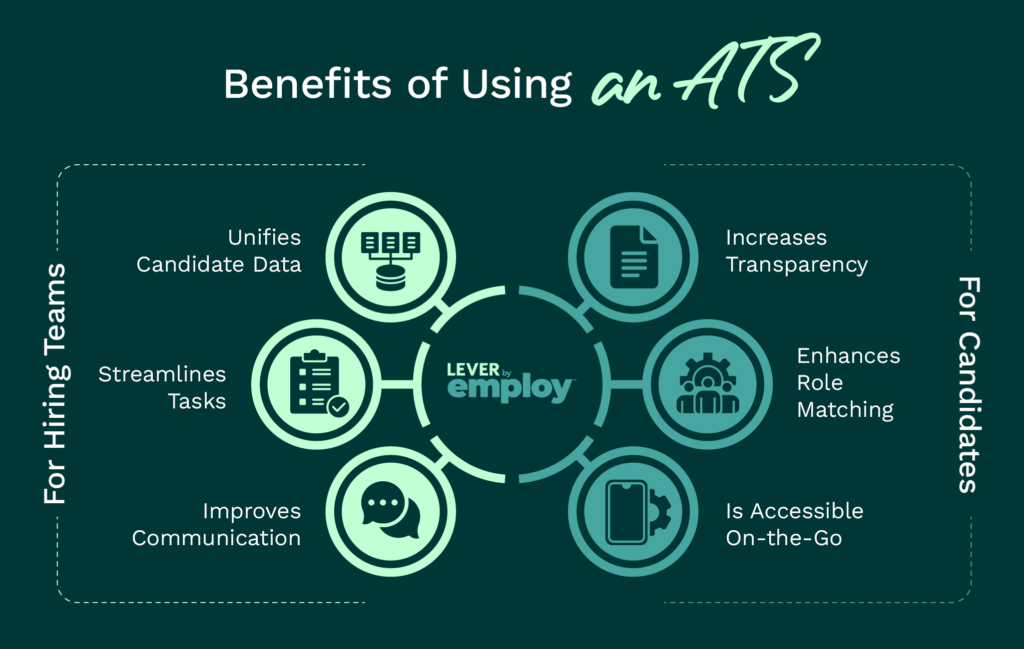
For Hiring Teams
- Unifies candidate data. Manually searching for and compiling candidate data is crucial, but it can also be tedious. With centralized candidate databases, you can pull the information you need in a fraction of the time and create more comprehensive reports.
- Streamlines tasks. In general, workflow management is a pain point for any nuanced team operation. An ATS can handle many menial tasks, allowing your team to increase your hiring capacity.
- Improves communication. Individually reaching out to each candidate isn’t only unnecessarily time-consuming but also more prone to human error. Automate your communication with an ATS, and never worry about any information falling through the cracks again.
For Candidates
- Increases transparency. The hiring process is as much about your candidates getting to know your organization as it is about you learning about them. An ATS ensures that candidates have a direct line of communication with the hiring team, ensuring no questions go unanswered and making them more likely to continue through the hiring process.
- Enhances role matching. Your organization might have several open roles, and it can be difficult to gauge which role each candidate is best suited for from a standalone job posting. Resume parsing technology can match candidates with the best roles for them, improving overall candidate satisfaction.
- Is accessible on the go. Your candidates are likely busy, and it’s up to you to keep up with them. An ATS with a mobile app ensures that they can actively participate in the hiring process wherever they are, whenever they need to.
What other talent acquisition technology is important to use?
While this guide focuses on applicant tracking systems, you should also understand the full talent acquisition technology landscape to inform your recruiting strategy. Let’s look at some other types of software and digital tools that you should know.
Talent Acquisition Software
Talent acquisition software solutions are comprehensive platforms built specifically for recruitment needs. Some examples of this type of tool include:
- Candidate relationship management (CRM). Intentionally prioritizing candidate relationships is necessary for keeping them engaged in your hiring process. CRM software is built for just that—it keeps candidates interested by segmenting communication, creating nuanced talent pools, and more.
- Employee referral software. Referred employees comprise a whopping 30% to 50% of all new employees, making referral programs critical for high-growth organizations. You can also leverage this sourcing method to engage current employees by rewarding them for each successful referral. This software helps you track each new hire and their referrer so you can distribute incentives and track sourcing data.
- DEI software. As previously mentioned, DEI software removes identifying information from candidate resumes. It can also support your efforts by detecting biased language in recruitment marketing materials and reporting hyper-specific DEI data.
Talent Acquisition Tools
These tools differ from the aforementioned systems because they aren’t made for recruitment but can still complement your processes. Here are some examples from Lever’s guide to recruiting tools:
- Internal communication tools (like Slack) allow you to contact and receive messages from your team members instantly.
- Video interviewing software (like BrightHire) provides a user-friendly interface to conduct live or asynchronous interviews.
- Aptitude assessment platforms (such as Bryq) enable your organization to conduct and collect actionable insights from candidate competency tests.
- Recruitment analytics and writing software (such as Datapeople) empower your team to optimize hiring posts with AI-powered tips and collaborative editing suites.
15 Best applicant tracking systems
Now that you understand the basics of applicant tracking systems, let’s review the top options on the market:
- Lever
- Jobvite
- JazzHR
- BambooHR
- Zoho Recruit
- Bullhorn
- Recruitee
- Comeet
- Loxo
- Pinpoint
- JobAdder
- TrakstarHire
- Jobsoid
- TalentLyft
- Ceipal
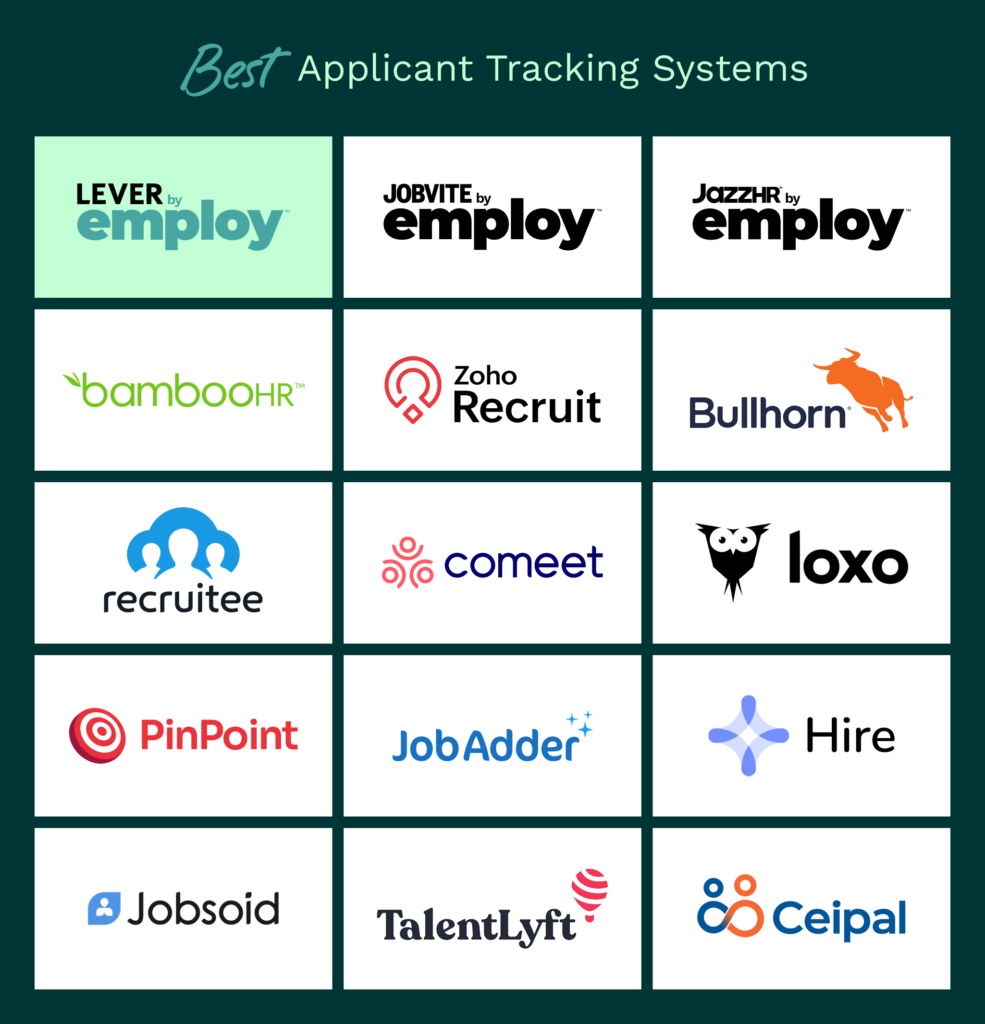
Best applicant tracking system overall: Lever
What is Lever?
Lever is the top ATS and CRM software solution built for mid-sized organizations. This all-in-one tool empowers mid-sized organizations to compete with larger brands for the top talent in the industry and achieve their growth goals.
Why Lever is the best applicant tracking system
Simply put, Lever is the standout, all-in-one recruitment system that gives you the most bang for your buck. Just take a look at all of these industry-leading features:
| Solution | Capabilities |
| Diversity, Equity, and Inclusion | Customizable candidate feedback surveys Reports filtered by race, ethnicity, gender, and other demographics |
| Reporting and Analytics | Visual Insights, a dynamic, configurable dashboard experience that allows you to visualize essential recruiting metrics Track data like candidate pipeline stages, job-posting engagement, offer acceptance rates, and more |
| High-Volume Hiring | Candidate profiles that centralize important demographic information Lever’s Automation Hub, which boosts capacity by automating activities like archiving, tagging, emailing, and advancing candidates |
| Recruitment Marketing | Lever’s Advanced Nurture, which empowers highly personalized, one-on-one communications with candidates Candidate Texting, which allows you to reach candidates whenever and wherever Career Site Builder, which allows you to launch a custom-branded job posting website |
Don’t just take our word for it—Lever has empowered the following companies to achieve their dream teams:
- Coupa (which grew their total headcount by 40% in only six months)
- Xepelin (which reduced reporting time by 85%)
- Entrata (which saved $40,000 on recruiting using Lever)
- Lime (which improved its time to hire by 30%)
- Netflix
- Eventbrite
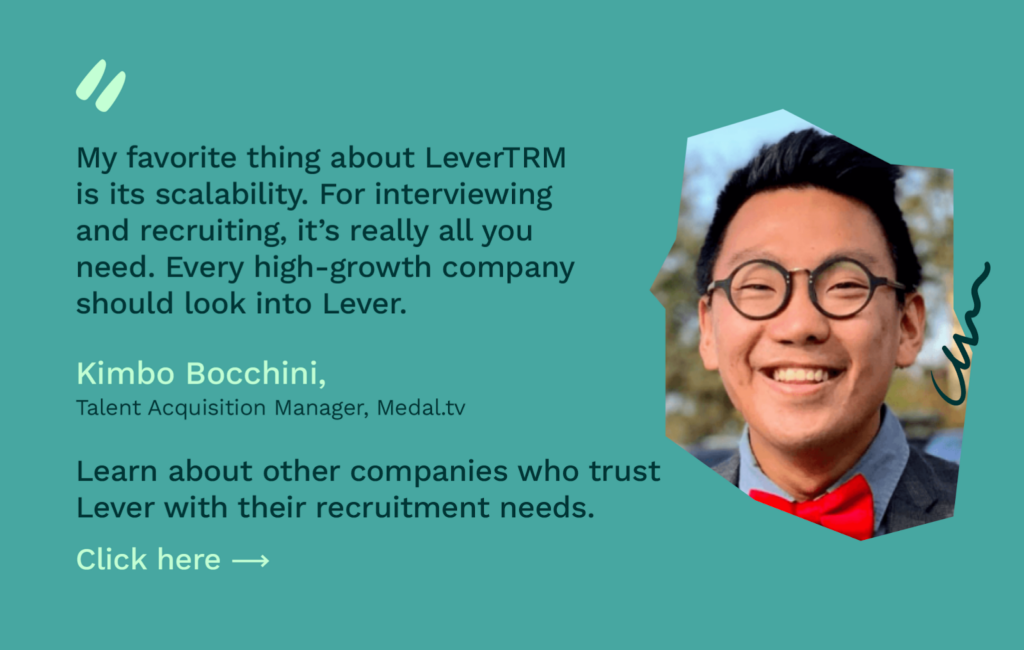
How to get started with Lever
Lever has helped its more than 22,000 customers recruit 600 million people. You can be next by contacting product experts for a demo.

Jobvite
Jobvite
- Ideal use case: Jobvite is an all-in-one ATS, CRM, and HR management software that is best for large enterprises with complex hiring needs.
- Strengths:
- Comprehensive support tools
- Highly customizable interface
- Integration with CRM tools to nurture candidates
- Special modules for internal recruiting
- How to get started:
- Reach out to the Jobvite team for a demo today.
JazzHR
- Ideal use case: JazzHR is an ATS and CRM suited for organizations with more straightforward hiring needs, such as small businesses and nonprofits.
- Strengths:
- Accessible pricing, starting at $75/month
- Feature-rich, providing a high ROI relative to its low price
- Unlimited candidate record storage
- Easy-to-read data reporting for new recruiting professionals
- How to get started:
- Click here to see a demo of JazzHR from client experts.
BambooHR
- Ideal use case: BambooHR is an ATS and onboarding platform that is best for mid-sized businesses looking for HR management and recruitment features.
- Strengths:
- HR and onboarding features, such as time tracking and paid time off management
- ATS function integrates seamlessly with HR tools
- Mobile app for on-the-go recruitment teams
- Weaknesses:
- Some users say that user experience updates are too infrequent, making navigating the platform tiresome.
- Though BambooHR has an ATS, its main offering is HR management, making it a less specialized choice for organizations looking for a standalone ATS.
- How to get started:
- Get a free trial of BambooHR here.
Zoho Recruit
- Ideal use case: Zoho Recruit is an ATS made for smaller organizations.
- Strengths:
- Affordable price point for recruitment organizations
- Optional integration with Zoho’s workflow management system and CRM
- Automated resume parsing
- Job posting template creation
- Weaknesses:
- Users report that Zoho customer service can be lacking and the software design is low-quality.
- How to get started:
- Request a free demo for Zoho Recruit here.
Bullhorn
- Ideal use case: Bullhorn is an ATS and CRM system designed for dedicated recruitment teams or staffing agencies.
- Strengths:
- Built for organizations with a high recruitment capacity and complex needs
- Users are satisfied with Bullhorn’s UI and interface
- AI-powered tools (like Copilot) boost efficiency and effectiveness
- Weaknesses:
- Users have reported lackluster customer service and implementation support from the Bullhorn team.
- How to get started:
- Click here to request a live demo of Bullhorn.
Recruitee
- Ideal use case: Recruitee is an ATS best suited for organizations with more straightforward hiring needs that want a team-focused experience.
- Strengths:
- Highly-customizable recruitment workflows
- Collaborative tools
- Integrates with many third-party tools
- Weaknesses:
- Some users say that they lost candidate data while exporting it to another system.
- Recruitee’s customer service has been criticized by some users for relying on chatbots.
- How to get started:
- Try Recruitee free for 18 days here.
Comeet
- Ideal use case: Comeet is an ATS made for small to mid-sized organizations that need highly collaborative features.
- Strengths:
- Out-of-the-box functionality
- Responsive customer support and extensive support resources
- Straightforward yet comprehensive dashboard setup
- Weaknesses:
- Some users say that Comeet is better suited as a pipeline visualization tool than a candidate database.
- How to get started:
- Click here to get a demo of Comeet.
Loxo
- Ideal use case: Loxo is an ATS and talent intelligence tool for recruiters, staffing agencies, and other hiring operations.
- Strengths:
- AI-powered sourcing ensures ideal role fits
- ChatGPT integration to fine-tune job postings
- Capacity for high-volume recruitment operations
- Integrated CRM for more informed decision-making
- Weaknesses:
- As a large-scale software, Loxo can be quite expensive, especially with paid add-ons.
- How to get started:
- You can get started with Loxo for free here.
Pinpoint
- Ideal use case: Pinpoint is an ATS created for mid-sized to large organizations’ in-house recruiting teams.
- Strengths:
- Marketing features help users improve employer branding
- Strong analytics and reporting features
- Modern, streamlined interface and look
- Weaknesses:
- Users have said the UX can be overly confusing.
- How to get started:
- Watch a demo of Pinpoint here.
JobAdder
- Ideal use case: JobAdder is an ATS and CRM software best suited for recruitment agencies and staffing firms that have robust hiring needs.
- Strengths:
- Highly-customizable and scalable for larger operations
- Integrates with recruiting tools like MailChimp and Xero, as well as more than 200 job boards
- Offers quality training resources, such as “how-to” videos
- Weaknesses:
- Users report unresponsive customer support and an inconsistent UI.
- How to get started:
- Request a free demo of JobAdder here.
Trakstar Hire
- Ideal use case: Trakstar Hire is an ATS made for growing companies looking to improve their recruiting approach.
- Strengths:
- As part of the Trakstar Suite, it integrates seamlessly with Trakstar Learn and Trakstar Perform
- Intuitive interface and user experience
- Implements HR-focused features, like offer management
- Weaknesses:
- Users report that the system is best for only hiring one person at a time.
- How to get started:
- Click here to request a live demo of Trakstar Hire.
Jobsoid
- Ideal use case: Jobsoid is an ATS and CRM software built for small- to mid-sized companies who want to ramp up their hiring.
- Strengths:
- Free plan available that supports one job posting and one user account in addition to more robust paid plans
- Mobile-friendly
- Very user-friendly, especially for new recruitment teams
- Weaknesses:
- Basic reporting features that don’t convey as many actionable insights or trends.
- How to get started:
- Book a free trial of Jobsoid here.
TalentLyft
- Ideal use case: TalentLyft is an ATS, CRM, and recruitment marketing platform made for small and mid-sized organizations.
- Strengths:
- Affordable price point
- Recruitment marketing suite helps hone in on overarching trends
- Customizable and collaborative workflows
- Weaknesses:
- Though it’s affordable, you don’t get as much bang for your buck as other systems in terms of how many active postings and user accounts you can have.
- How to get started:
- Click here to start your free trial of TalentLyft.
Ceipal
- Ideal use case: Ceipal is an ATS and candidate database for tech-savvy, small to mid-sized organizations.
- Strengths:
- Specific focus on healthcare recruiting
- AI-driven Ceipal Copilot can pull specific, detailed reports
- Verifies candidate credentials easily
- Weaknesses:
- Ceipal’s strong data analytics focus can make the software challenging for beginners to navigate.
- How to get started:
- Get a demo of Ceipal here.
How to choose an ATS
Now that you know what the best applicant tracking systems on the market are, let’s walk through how to pick the right one for your organization.
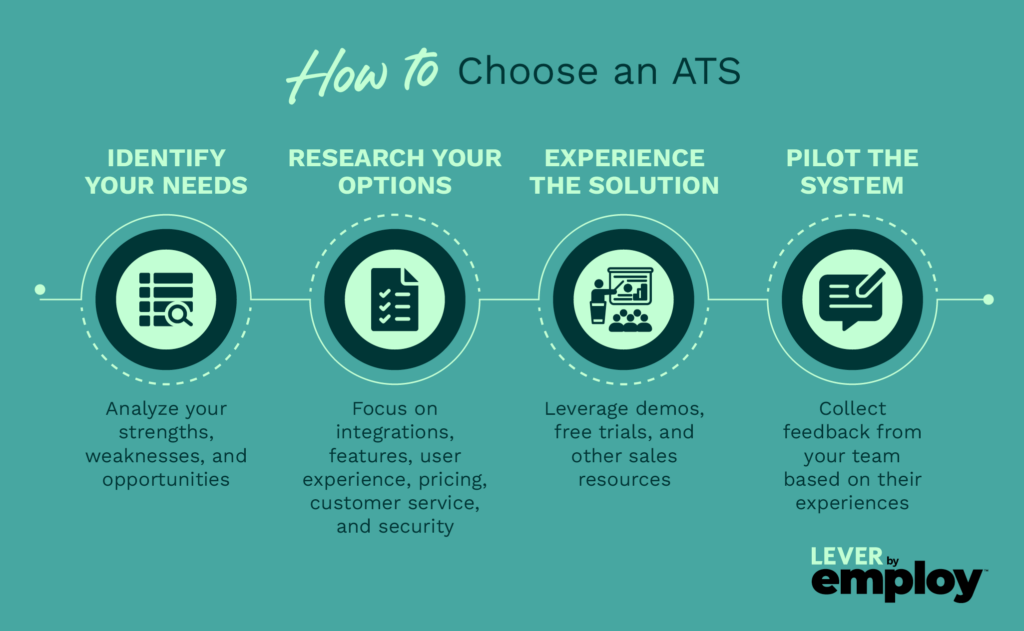
1. Identify your needs
Like any new organizational process or activity, your implementation plan for your ATS should be based on your overarching priorities and goals. Answer the following key questions during this stage:
- Like any new organizational process or activity, your implementation plan for your ATS should be based on your overarching priorities and goals. Answer the following key questions during this stage:
- What are your recruitment goals? For example, you might want to increase your total headcount by 10% by the end of the year or decrease your time to hire by 30%.
- What are your recruitment strengths and weaknesses? An example of a strength could be that your team is experienced with using applicant tracking systems in the past, whereas a weakness could be that your recruitment budget recently decreased.
- What is your implementation timeline? Your implementation plan will vary greatly if you have six months to set up your ATS versus if you have an entire year.
- How many team members will use the ATS? If you have a dedicated recruitment team, you’ll likely need numerous seats on your plan, but an organization without a recruiter might only need one shared user account.
- How will the ATS factor into your existing tech stack? Choosing an ATS that integrates with the tools you already have is more budget-friendly and efficient than starting from scratch.
- What are your candidates’ preferences? Review the candidate feedback you’ve collected in the past about your recruitment process and note any patterns in their responses. For instance, candidates might have requested more consistent communication from your team, which could indicate that you need software with automated messaging features.
2. Research your options
Once you’ve determined your priorities, conduct initial research into the best applicant tracking system for your needs. Here are some important considerations for your search:
- Key features. Does the ATS allow you to achieve your goals efficiently?
- User experience. Is the software easy to use, especially given your team’s comfort with technology?
- Pricing or budget. Does the cost of ATS licenses, training materials, and working with an implementation consultant fall within your budget?
- Customer service. How attentive and helpful are customer service representatives?
- Security and compliance. Does the ATS comply with all necessary data security regulations and standards?
- Integration potential. Does the ATS integrate with your existing nonnegotiable solutions? (Check how to locate integrations below)
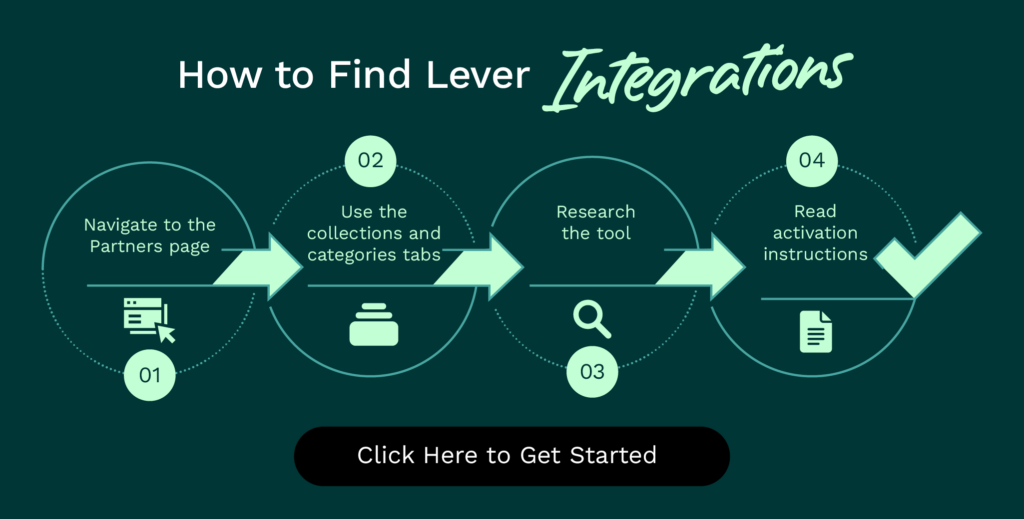
3. Experience the solution firsthand
Before you make a final buying decision, leverage free demos or trials for each solution. It’s best to create a touchpoint with a product expert throughout the trial process so you can ask questions as they come up.
That said, don’t just rely on product experts to shape your perception of the software. Read third-party reviews from tech forums or official review websites so you can make a well-rounded choice.
4. Pilot the system with your team
It’s the moment you’ve been waiting for—piloting your chosen ATS with your entire team! You might experience some growing pains during the rollout period as your team gets used to the new technology, but hopefully, you’ll be comfortably up and running in a few months.
However, if you receive multiple reports of issues and feedback from your team, it may indicate that you need to talk with a product expert or even pivot to another solution. Ensure you’ve exhausted your options before parting ways with your current provider, such as talking with a third-party software specialist and your leadership team.
Next steps
Choosing and implementing an ATS is a nuanced process. Even when you make a final decision, there are more elements to consider throughout the rollout stage, such as the long-term future of your organization. Remember that this is a constantly evolving process, so keep in touch with your team as you implement your ATS to ensure everything goes smoothly.
